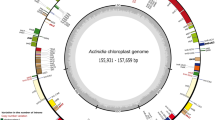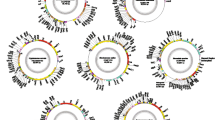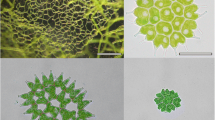Abstract
The molecular phylogeny of red algal actin genes, with emphasis on the paraphyletic “Bangiophyceae,” was examined and compared to the rhodophyte SSU rDNA phylogeny. Nineteen new genomic actin sequences and seven SSU rDNA sequences were obtained and subjected to diverse phylogenetic analyses (maximum likelihood, distance/neighbor-joining, maximum parsimony, Bayesian analyses, and, with respect to protein sequences, also quartet puzzling). The actin trees confirmed most of the major clades found in the SSU rDNA phylogenies, although with a lower resolution. An actin gene duplication in the florideophycean lineage is reported, presumably related to an increased complexity of sexual reproduction. In addition, the distribution and characteristics of spliceosomal introns found in some of the actin sequences were examined. Introns were found in almost all florideophycean actin genes, whereas only two bangiophyte sequences contained introns. One intron in the florideophycean actin genes was also found in metazoan, and, shifted by one or two nucleotides, in a glaucocystophyte, a cryptophyte, and two fungal actin genes, and thus may be an ancient intron.




Similar content being viewed by others
References
Altschul SF, Madden TL, Schäffer AA, Zhang J, Zhang Z, Miller W, Lipman DJ (1997) Gapped BLAST and PSI-BLAST: a new generation of protein database search programs. Nucleic Acids Res 25:3389–3402
An SS, Möpps B, Weber K, Bhattacharya D (1999) The origin and evolution of green algal and plant actins. Mol Biol Evol 16:275–285
An Y-Q, McDowell JM, Huang S, McKinney EC, Chambliss S, Meagher RB (1996) Strong, constitutive expression of the Arabidopsis ACT2/ACT8 actin subclass in vegetative tissues. Plant J 10:107–121
Arad (Malis) S, Richmond A (2004) Industrial production of microalgal cell-mass and secondary products—species of high potential: Porphyridium sp. In: Richmond A, (ed) Handbook of microalgal culture: Biotechnology and applied phycology. Blackwell Science, Oxford, pp 289–298
Baird WV, Meagher RB (1987) A complex gene superfamily encodes actin in Petunia. EMBO J 6:3223–3231
Bhattacharya D, Weber K (1997) The actin gene of the glaucocystophyte Cyanophora paradoxa: analysis of the coding region and introns, and an actin phylogeny of eukaryotes. Curr Genet 31:439–446
Bhattacharya D, Weber K, An SS, Berning-Koch W (1998) Actin phylogeny identifies Mesostigma viride as a flagellate ancestor of the land plants. J Mol Evol 47:544–550
Bird CJ, McLachlan JL (1992) Seaweed flora of the Maritimes. 1. Rhodophyta—The red algae. Biopress, Bristol, UK
Bouget F-Y, Kerbourc’h C, Liaud M-F, Loiseaux de Goër S, Quatrano RS, Cerff R, Kloareg B (1995) Structural features and phylogeny of the actin gene of Chondrus crispus (Gigartinales, Rhodophyta). Curr Genet 28:164–172
Burger G, Saint-Louis D, Gray MW, Lang BF (1999) Complete sequence of the mitochondrial DNA of the red alga Porphyra purpurea: Cyanobacterial introns and shared ancestry or red and green algae. Plant Cell 11:1675–1694
Buschmann AH, Correa JA, Westermeier R, Hernandez-Gonzalez MD, Norambuena R (2001) Red algal farming in Chile: a review. Aquaculture 194:203–220
Chang S, Pureyear J, Cairney J (1993) A simple and efficient method for isolating RNA from pine treesPlant Mol Biol Rep 11:1136
Cho S, Jin S-W, Cohen A, Ellis RE (2004) A phylogeny of Caenorhabditis reveals frequent loss of introns during nematode evolution. Genome Res 14:1207–1220
Coghlan A, Wolfe KH (2004) Origins of recently gained introns in Caenorhabditis. Proc Natl Acad Sci USA 101:11362–11367
Cohen E, Arad (Malis) S (1989) A closed system for outdoor cultivation of Porphyridium. Biomass 18:59–67
Cole KM, Sheath RG (Eds) (1995) Biology of the red algae Cambridge University Press, Cambridge
Dibb NJ, Newman AJ (1989) Evidence that introns arose at proto-splice sites. EMBO J 8:2015–2021
dos Remedios CG, Chabra D, Kekic M, Dedova IV, Tsubakihara M, Berry DA, Nosworthy NJ (2003) Actin binding proteins: regulation of cytoskeletal microfilaments. Physiol Rev 83:433–473
Drouin G, Dover GA (1990) Independent gene evolution in the potato actin gene family demonstrated by phylogenetic procedures for resolving gene conversions and the phylogeny of angiosperm actin genes. J Mol Evol 31:132–150
Fedorov A, Merican AF, Gilbert W (2002) Large-scale comparison of intron positions among animal, plant and fungal genes. Proc Natl Acad Sci USA 99:16128–16133
Felsenstein J (1981) Evolutionary trees from DNA sequences: A maximum likelihood approachJ Mol Evol 17:368–376
Felsenstein J (2004) Phylip—Phylogeny Inference Package. http://evolution.gs.washington.edu/phylip/doc/main.html
Galtier N, Gouy M, Gautier C (1996) SeaView and Phylo_win: two graphic tools for sequence alignment and molecular phylogeny. CABIOS 12:543–548
Garbary DJ, McDonald AR (1996a) Fluorescent labeling of the cytoskeleton in Ceramium strictum (Rhodophyta). J Phycol 32:85–93
Garbary DJ, McDonald AR (1996b) Actin rings in cytokinesis or apical cells in red algae. Can J Bot 74:971–974
Garbary DJ, McDonald AR, Duckett JG (1992) Visualization of the cytoskeleton in red algae using fluorescent labeling. New Phytol 120:435–444
Guillard RRL, Hargraves PE (1993) Stichochrysis immobilis is a diatom, not a chrysophyte. Phycologia 32:234–236
Hoef-Emden K, Melkonian M (2003) Revision of the genus Cryptomonas (Cryptophyceae): a combination of molecular phylogeny and morphology provides insights into a long-hidden dimorphism. Protist 154:371–409
Hoef-Emden K, Marin B, Melkonian M (2002) Nuclear and nucleomorph SSU rDNA phylogeny in the Cryptophyta and the evolution of cryptophyte diversity. J Mol Evol 55:161–179
Inagaki Y, Simpson AGB, Dacks JB, Roger AJ (2004) Phylogenetic artifacts can be caused by leucine, serine and arginine codon usage heterogeneity: dinoflagellate plastid origins as a case study. Syst Biol 53:582–593
Jones DT, Taylor WR, Thornton JM (1992) The rapid generation of mutation data matrices from protein sequences. CABIOS 8:275–282
Jones RF, Speer HL, Kury W (1963) Studies on the growth of the red alga Porphyridium cruentum. Physiol Plant 16:636–643
Kies L, (1967) Über Zweiteilung und Zygotenbildung bei Roya obtusa (Bre.) West & West. Mitt Staatsinst Allg Bot Hamb 12:1091–1109
Kim GH, Kim S-H (1999) The role of F-actin during fertilization of the red alga Aglaothamnion oosumiense (Rhodophyta).J Phycol 35:806–814
Kitade Y, Fukuda S, Nakajima M, Watanabe T, Saga N (2002) Isolation of a cDNA encoding a homologue of actin from Porphyra yezoensis (Rhodophyta). J Appl Phycol 14:135–141
Kornmann P, Sahling P–H (1977) Meeresalgen von Helgoland. Benthische Grün-, Braun- und Rotalgen. Helgol wiss Meeresunters 29:1–289
Leander BS, Keeling PJ (2004) Early evolutionary history of dinoflagellates and apicomplexans (Alveolata) as inferred from hsp90 and actin phylogenies. J Phycol 40:341–350
Lembi CA, Waaland JR (Eds) (1988) Algae and human affairs. Cambridge University Press, Cambridge/New York
Lewis LA, McCourt RM (2004) Green algae and the origin of land plants. Am J Bot 91:1535–1556
Liaud M-F, Brandt U, Cerff R (1995) The marine red alga Chondrus crispus has a highly divergent β-tubulin gene with a characteristic 5′ intron: functional and evolutionary implications. Plant Mol Biol 28:313–325
Lynch M, Richardson A, (2002) The evolution of spliceosomal introns. Curr Opin Genet Dev 12:701–710
Matzuzaki M, Misumi O, Shin-i T, Maruyama S, Takahara M, Miyagishima S, Mori T, Nishida K, Yagisawa F, Nishida K, Yoshida Y, Nishimura Y, Nakao S, Kobayashi T, Momoyama Y, Higashiyama T, Minoda A, Sano M, Nomoto H, Oishi K, Hayashi H, Ohta F, Nishizaka S, Haga S, Miura S, Morishita T, Kabeya Y, Terasawa K, Suzuki Y, Ishii Y, Asakawa S, Takano H, Ohta N, Kuroiwa H, Tanaka K, Shimizu N, Sugano S, Sato N, Nozaki H, Ogasawara N, Kohara Y, Kuroiwa T (2004) Genome sequence of the ultrasmall unicellular red alga Cyanidioschyzon merolae 10D. Nature (Lond) 428:653–657
McCurdy DW, Kovar DR, Staiger CJ (2001) Actin and actin-binding proteins in higher plants. Protoplasma 215:89–104
McDowell JM, Huang S, McKinney EC, An Y-Q, Meagher RB (1996) Structure and evolution of the actin gene family in Arabidopsis thaliana. Genetics 142:587–602
McFadden GI, Melkonian M (1986) Use of Hepes buffer for microalgal culture media and fixation for electron microscopy.Phycologia 25:551–557
McLean BG, Huang SR, McKinney EC, Meagher RB (1990) Plants contain highly divergent actin isovariants. Cell Motil Cytoskeleton 17:276–290
Meagher RB, McKinney EC, Vitale AV (1999) The evolution of new structures—Clues from plant cytoskeletal genes. Trends Genet 15:278–284
Moreira D, Le Guyader, Philippe H (2000) The origin of the red algae and the evolution of chloroplasts. Nature (Lond) 405:69–72
Müller KM, Oliveira MC, Sheath R, Bhattacharya D (2001) Ribosomal DNA phylogeny of the Bangiophycidae (Rhodophyta) and the origin of secondary plastids. Am J Bot 88:1390–1400
Nozaki H, Matzuzaki M, Takahara M, Misumi O, Kuroiwa H, Hasegawa M, Shin-i T, Kohara Y, Osagawara N, Kuroiwa T (2003) The phylogenetic position of red algae revealed by multiple nuclear genes from mitochondria-containing eukaryotes and an alternative hypothesis on the origin of plastids. J Mol Evol 56:485–497
Ohta T (1994) Further examples of evolution by gene duplication revealed through DNA sequence comparisons. Genetics 138:1331–1337
Patel AA, Steitz JA (2003) Splicing double: insights from the second spliceosome. Nature Rev Mol Cell Biol 4:960–970
Patwary MU, van der Meer JP (1994) Application of RAPD markers in an examination of heterosis in Gelidium vagum (Rhodophyta). J Phycol 30:91–97
Posada D, Crandall KA (1998) Modeltest: testing the model of DNA substitution. Bioinformatics 14:817–818
Ragan MA, Gutell RR (1995) Are red algae plants?. Bot J Linn Soc 116:81–105
Ragan MA, Bird CJ, Rice EL, Gutell RR, Murphy CA, Singh RK (1994) A molecular phylogeny of the marine red algae (Rhodophyta) based on the nuclear small-subunit rRNA gene. Proc Natl Acad Sci USA 91:7276–7280
Rodríguez F, Oliver JF, Marín A, Medina JR (1990) The general stochastic model of nucleotide substitution. J Theor Biol 142:485–501
Rogozin IB, Wolf YI, Sorokin AV, Mirkin BG, Koonin EV (2003) Remarkable interkingdom conservation of intron positions and massive, lineage-specific intron loss and gain in eukaryotic evolution. Curr Biol 13:1512–1517
Ronquist F, Huelsenbeck JP (2003) MrBayes 3: Bayesian phylogenetic inference under mixed models. Bioinformatics 19:1572–1574
Roy SW (2003) Recent evidence for the exon theory of genes. Genetica 118:251–266
Saunders GW, Bailey JC (1997) Phylogenesis of pit-plug-associated features in the Rhodophyta: inferences from molecular systematic data. Can J Bot 75:1436–1447
Saunders SW, Hommersand MH (2004) Assessing red algal supraordinal diversity and taxonomy in the context of contemporary systematic data. Am J Bot 91:1494–1507
Schlösser UG (1994) SAG—Sammlung von Algenkulturen at the University of Göttingen, catalogue of strains 1994. Bot Acta 107:113–186
Schmidt HA, Strimmer K, Vingron M, von Haeseler A (2002) TREE-PUZZLE: maximum likelihood phylogenetic analysis using quartets and parallel computing. Bioinformatics 18:502–504
Sherwood AR, Sheath RG (1999) Biogeography and systematics of Hildenbrandia (Rhodophyta, Hildenbrandiales) in North America: inferences from morphometrics and rbcL and 18S rRNA gene sequence analyses. Eur J Phycol 34:523–532
Shrestha RP, Weinstein Y, Bar-Zvi D, Arad (Malis) S (2004) A glycoprotein non-covalently associated with cell-wall polysaccharide of the red microalga Porphyridium sp. (Rhodophyta). J Phycol 40:568–580
Stibitz TB, Keeling PJ, Bhattacharya D (2000) Symbiotic origin of a novel actin gene in the cryptophyte Pyrenomonas helgolandii. Mol Biol Evol 17:1731–1738
Stoltzfus A, Logsdon JM, Palmer JD, Doolittle WF (1997) Intron “sliding” and the diversity of intron positions. Proc Natl Acad Sci USA 94:10739–10744
Swofford DL (2002) PAUP*: Phylogenetic analysis using parsimony (*and other methods). 4.0 Beta for UNIX or OpenVMS. Sinauer Associates, Sunderland, MA
Tamura K, Nei M (1993) Estimation of the number of nucleotide substitutions in the control region of mitochondrial DNA in humans and chimpanzees. Mol Biol Evol 10:512–526
van den Hoek C, Mann DG, Jahns HM (Eds) (1995) Algae. An introduction to phycology. Cambridge University Press, Cambridge
Voigt K, Wostemeyer J (2001) Phylogeny and origin of 82 zygomycetes from all 54 genera of the Mucorales and Mortierellales based on combined analysis of actin and translation elongation factor EF–1 alpha genes. Gene 270:113–120
Weber K, Kabsch W (1994) Intron positions in actin genes seem unrelated to the secondary structure of the protein. EMBO J 13:1280–1286
Weber AP, Oesterhelt C, Gross W, Bräutigam A, Imboden LA, Krassovskaya I, Linka N, Truchina J, Schneidereit J, Voll H, Voll LM, Zimmermann M, Jamai A, Riekhof WR, Yu B, Garavito RM, Benning C (2004) EST-analysis of the thermo-acidophilic red microalga Galdieria sulphuraria reveals potentials for lipid A biosynthesis and unveils the pathway of carbon export from rhodoplasts. Plant Mol Biol 55:17–32
Wilson SM, Pickett-Heaps JD, West JA (2002) Fertilization and the cytoskeleton in the red alga Bostrychia moritziana (Rhodomelaceae, Rhodophyta). Eur J Phycol 37:509–522
Yang Z (1996) Among-site variation and its impact on phylogenetic analyses. Trends Ecol Evol 11:367–372
Yoon HS, Hackett JD, Pinto G, Bhattacharya D (2002) The single, ancient origin of chromist plastids. Proc Natl Acad Sci USA 99:15507–15512
Acknowledgments
This study was funded by the German–Israeli Foundation for Scientific Research and Development (GIF Grant I-734-63.12/2002).
Author information
Authors and Affiliations
Corresponding author
Additional information
[Reviewing Editor: Dr. Yves Van de Peer]
Rights and permissions
About this article
Cite this article
Hoef-Emden, K., Shrestha, R.P., Lapidot, M. et al. Actin Phylogeny and Intron Distribution in Bangiophyte Red Algae(Rhodoplantae). J Mol Evol 61, 360–371 (2005). https://doi.org/10.1007/s00239-004-0366-3
Received:
Accepted:
Published:
Issue Date:
DOI: https://doi.org/10.1007/s00239-004-0366-3




